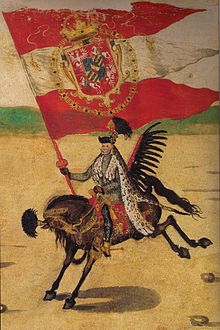
Szczerbiec is the ceremonial sword used in the coronations of most Polish monarchs from 1320 to 1764. It now is displayed in the treasure vault of the royal Wawel Castle in Kraków, as the only preserved part of the medieval Polish crown jewels. The sword is noted for its hilt, decorated with magical formulae, Christian symbols, and floral patterns, as well as for the narrow slit in the blade which holds a small shield with the coat of arms of Poland. The name of the sword, derived from the Polish word szczerba and wrongly its meaning is perceived as "the Notched Sword" or "the Jagged Sword", though the edges of its blade are straight and smooth. Proper meaning and rendering into English would be "the Notching/Jagging Sword" — as "a sword that is meant to notch/jag other weapons".

The national flag of Poland consists of two horizontal stripes of equal width, the upper one white and the lower one red. The two colours are defined in the Polish constitution as the national colours. A variant of the flag with the national coat of arms in the middle of the white fess is legally reserved for official use abroad and at sea. A similar flag with the addition of a white eagle is used as the naval ensign of Poland.

The coat of arms of Lithuania is a mounted armoured knight holding a sword and shield, known as Vytis. Since the early 15th century, it has been Lithuania's official coat of arms and is one of the oldest European coats of arms. It is also known by other names in various languages, such as Waykimas, Pagaunė in the Lithuanian language or as Pogonia, Pogoń, Пагоня in the Polish, and Belarusian languages. Vytis is translatable as Chase, Pursuer, Knight or Horseman, similar to the Slavic vityaz. Historically – raitas senovės karžygys or in heraldry – raitas valdovas.

The coat of arms of Poland is a white, crowned eagle with a golden beak and talons, on a red background.

The coat of arms of the Polish–Lithuanian Commonwealth was the symbol of the Polish–Lithuanian Commonwealth, representing the union of the Crown of the Polish Kingdom and Grand Duchy of Lithuania.
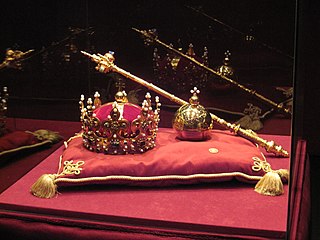
The only surviving original piece of the Polish crown jewels from the time of the Piast dynasty is the ceremonial sword Szczerbiec. It is currently on display along with other preserved royal items at the Wawel Royal Castle Museum in Kraków.

The Order of Merit of the Republic of Poland is a Polish order of merit created in 1974, awarded to persons who have rendered great service to Poland. It is granted to foreigners or Poles resident abroad. As such it is sometimes referred to as a traditional "diplomatic order".

The coat of arms that serves as the symbol of the Lublin Voivodeship, Poland depicts a white (silver) male jumping cervus (deer), with a yellow (golden) crown on its neck, placed on a red background. The current design of the coat of arms was designed by Andrzej Heidrich, and adopted in 2002.

The pennant of the president of the Republic of Poland, Commander-in-Chief of the Armed Forces of the Republic of Poland is a presidential standard (flag) used in the Polish Armed Forces to mark the presence and pay respect to the president of the Republic of Poland who is also ex officio the commander-in-chief of the Armed Forces. The pennant is raised on Polish Navy ships when the president is officially on board, as well as on land, if the president is present. The design of the pennant is based directly on the pre-war Banner of the Republic of Poland which used to be part of presidential insignia.

Military eagles are military insignia used in the Polish Armed Forces, based on the White Eagle of the Polish coat of arms. They are used on elements of military uniforms such as hats and buttons, as well as on military banners, flags, medals, emblems, publications etc. One variant exists for each of the five branches of the Armed Forces. Additionally, the Minister of National Defence, the Marshal of Poland, and generals and admirals use their own variants.

The Grunwald Swords are a pair of simple bare swords sent as a mocking "gift" by Ulrich von Jungingen, the Grand Master of the Order of Teutonic Knights, to King Władysław II Jagiełło of Poland and Grand Duke Vytautas of Lithuania. The swords were sent on 15 July 1410, just before the Battle of Grunwald (Tannenberg), as a symbolic invitation to engage Jungingen's forces in battle. After the Polish–Lithuanian victory, both swords were taken as a war trophy by King Władysław II to Kraków, Poland's capital at the time, and placed in the treasury of the Royal Wawel Castle.

The naval ensignof the Republic of Poland is a swallowtailed horizontal bicolor of white and red with the national coat of arms in the middle of the white stripe. It has been used by the Polish Navy since 1919.
National symbols of Poland are the tangible and intangible symbols, emblems or images that are found in Poland to represent the country's unique customs, traditions, cultural life, and its over 1000-year history. These symbols serve as the nation's portrayal of patriotism and dedication to their national identity. The Polish people and the Polish diaspora around the world take great pride in their native country, and associate themselves with the colours white and red. The expression biało-czerwoni ("whitereds") is widely used by Poles when referring to their compatriots. A crowned white-tailed eagle on a red shield or background has been Poland's national symbol and coat of arms since the Middle Ages. Other unofficial symbols feature visual personifications, music of Chopin, polonaise and mazurka dances, animals such as the European bison or the white stork, apples, red poppy flowers and religious insignia of the Roman Catholic church. Several have been popularised in recent years, notably the winged hussars.

The coat of arms that serves as the official symbol of the Masovian Voivodeship, Poland, consists of a red escutcheon, that features a white (silver) eagle, with raised wings, and its head turned left. Its current version had been designed by Andrzej Heidrich, and adopted in 2006.

The coat of arms of the Lesser Poland Voivodeship, Poland features a white (silver) eagle with a yellow (golden) crown on his head that is turned left, a beak, legs, and a stripes on its wings, with the charge placed on the red background. It was designed by Wojciech Drelicharz, Zenon Piech, and Barbara Widłak, and adopted in 1999.
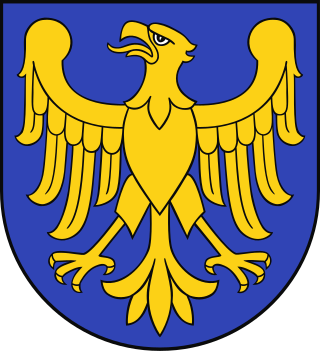
The coat of arms, that serves as the symbol of the Silesian Voivodeship, Poland, features a yellow (golden) eagle on a blue background. The current version of the coat of arms was adopted in 2001, and based on the historical coats of arms of Upper Silesia.
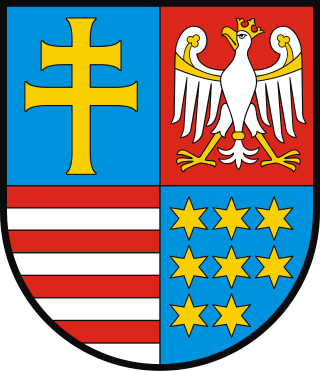
The coat of arms that serves as the symbol of the Świętokrzyskie Voivodeship, Poland, consists of the Iberian style escutcheon (shield), with square top and rounded base, that is divided in the 2 by 2 chessboard pattern. The top left field features a yellow patriarchal cross. The top right field features a white eagle with yellow crown, beak, legs, stripes on its wings, and a ring on its tail. The bottom left field features eight yellow six-pointed starts, placed in three rows, each with three stars, with the exception of the bottom row, that only had 2 stars, placed to the left.
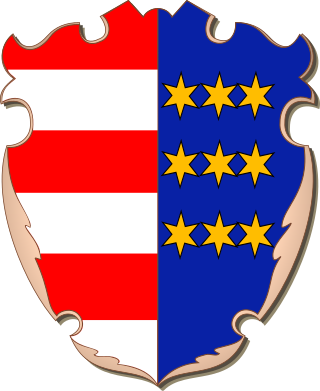
The historical coat of arms, that served as the symbol of the Sandomierz Land, and the Sandomierz Voivodeship of the Kingdom of Poland, from 14th to 18th centuries, was divided into two fields, with the left field consisting of six stripes, that were alternatining either between red and white, or red and yellow colours, and with the right field consisting of several yellow six-armed stars, which number altered between seven and nine.





